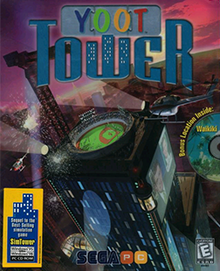Mario Kart is a series of kart racing games based on the Mario franchise developed and published by Nintendo. Players compete in go-kart races while using various power-up items. It features characters and courses mostly from the Mario series as well as other gaming franchises such as The Legend of Zelda, Animal Crossing, F-Zero, Excitebike, and Splatoon.

The Sims is a social simulation video game developed by Maxis and published by Electronic Arts in 2000. The game allows players to create and control virtual people, called "Sims", and manage their daily lives in a suburban setting. The game features an open-ended gameplay, where players can choose their own goals and objectives, and customize their Sims' appearance, personality, skills, relationships, and environment. A series of expansion packs were also released that add new content and features to the game, such as new careers, items, locations, and scenarios.

SimCity 4 is a city-building simulation computer game developed by Maxis, a subsidiary of Electronic Arts. The game was released in January 2003 for Microsoft Windows and in June 2003 for Mac OS X. It is the fourth major installment in the SimCity series. SimCity 4 has a single expansion pack called Rush Hour which adds features to the game. SimCity 4: Deluxe Edition contains the original game and Rush Hour combined as a single product.

Railroad Tycoon is a business simulation game series. There are five games in the series; the original Railroad Tycoon (1990), Railroad Tycoon Deluxe (1993), Railroad Tycoon II (1998), Railroad Tycoon 3 (2003), and Sid Meier's Railroads! (2006).

The Sims 2 is a 2004 social simulation video game developed by Maxis and published by Electronic Arts. It is the second major title in The Sims series, and is the sequel to The Sims. The game was released for Microsoft Windows on September 14, 2004, and a port for MacOS by Aspyr was released on June 17, 2005. Eight expansion packs and nine "stuff packs" were subsequently released between 2005 and 2008. In addition, versions of The Sims 2 were released on various video game consoles, including the PlayStation 2, Xbox, Nintendo DS, and GameCube, and mobile platforms, including the Nokia Ovi Store. Unlike the original, the handheld and console versions are more storyline-based. The three handheld versions of the game are completely different among themselves, unlike the home console versions of the game, which are virtually identical to each other. A sequel, The Sims 3, was released in June 2009.
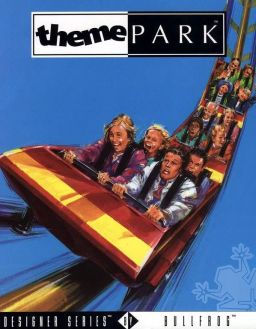
Theme Park is a construction and management simulation video game developed by Bullfrog Productions and published by Electronic Arts in 1994. The player designs and operates an amusement park, with the goal of making money and creating theme parks worldwide. The game is the first instalment in Bullfrog's Theme series and their Designer Series.
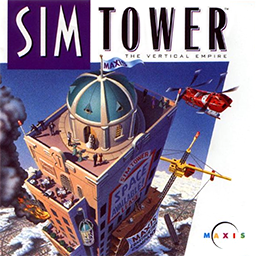
SimTower: The Vertical Empire is a construction and management simulation video game developed by OPeNBooK and released in 1994 for Microsoft Windows and Macintosh System 7. Outside Japan, the game was published by Maxis and branded as part of their Sim series. Ports for Sega Saturn and 3DO were released in 1996. A sequel titled The Tower II was released in 1998 and called Yoot Tower outside Japan.
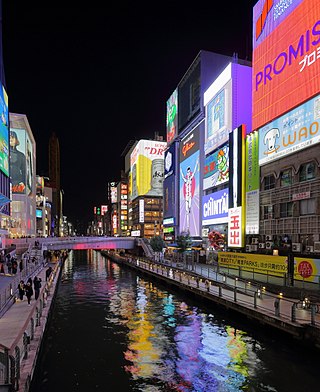
Dōtonbori or Dōtombori is a district in Osaka, Japan. Known as one of Osaka's principal tourist and nightlife areas, the area runs along the Dōtonbori canal from Dōtonboribashi Bridge to Nipponbashi Bridge in the Namba district of the city's Chūō ward. Historically a theater district, it is now a popular nightlife and entertainment area characterized by its eccentric atmosphere and large illuminated signboards.
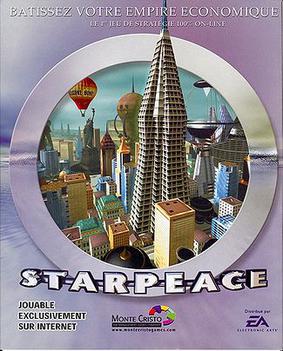
StarPeace is an open-ended online city-building computer game, in which thousands of players build and develop a large inhabitable world. Similar in many ways to SimCity 4, one major difference being StarPeace is fully online, and players compete against each other to build industrial, residential, retail markets, and more on a single planet, making sure to gain a steady income in which to fund their future expansion. Similar to other Sim games, there is no definite end. The planet continues to grow in a continuously evolving state as each player adds more buildings to it. Each player can choose between a large selection of planets on which to play.

The Tower SP is a 2005 construction and management simulation video game developed by Vivarium and published by Nintendo for the Game Boy Advance. It was released in March 2005 in Japan and April the same year by Sega in North America. It is a port and revision of SimTower (1994), which Vivarium's predecessor OPeNBook developed, with some elements of its sequel Yoot Tower (1998). In the game, the player is tasked to construct a tower for their company boss, Yama.
Vivarium Inc. is a Japanese video game developer founded in 1996 by company president Yoot Saito. It is famous for designing innovative video games which use voice recognition technology. Seaman for the Dreamcast is their most famous game to date. Odama, for the GameCube, was also developed by Vivarium.
Nintendo Zone was a download service and an extension of the DS Download Station. Users could access content, third-party data, and other services from a hotspot or download station. The service had demos of upcoming and currently available games and may have location-specific content. When the service debuted, users could also connect to the Nintendo Wi-Fi Connection and DSi Shop.

MySims is a video game developed by EA Redwood Shores and published by Electronic Arts as a spin-off to Maxis' The Sims franchise for the Wii and Nintendo DS in September 2007, re-released for Microsoft Windows and mobile phones in 2008, and for BlackBerry in 2009. The game sold 3.7 million units as of 2008.

The Sims 3 is a 2009 social simulation video game developed by the Redwood Shores studio of Maxis, and published by Electronic Arts. Part of The Sims series, it is the sequel to The Sims 2. It was released on June 2, 2009, for Microsoft Windows, MacOS, and mobile versions. Console versions were released for PlayStation 3, Xbox 360, and Nintendo DS in October 2010 and a month later for Wii. The Windows Phone version was released on October 15, 2010. A Nintendo 3DS version, released on March 27, 2011, was one of the platform's launch titles.

The Sims is a series of life simulation video games developed by Maxis and published by Electronic Arts. The franchise has sold nearly 200 million copies worldwide, and is one of the best-selling video game series of all time. It is also part of the larger Sim series, started by SimCity in 1989.
The Sims Carnival was a casual games series created by Electronic Arts. The Sims Carnival had two separate product lines. First, it was an online community of crowd-sourced games. Second, it was a line of packaged game titles sold via retail stores and digital download.
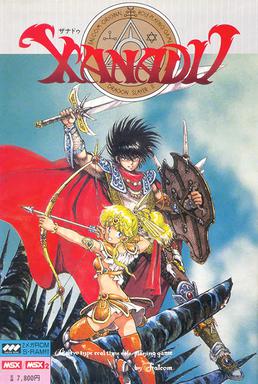
Xanadu, also known as Xanadu: Dragon Slayer II, is an action role-playing game developed by Nihon Falcom and released in 1985 for the PC-8801, X1, PC-8001, PC-9801, FM-7 and MSX computers. Enhanced remakes were later released for the Sega Saturn, PC-9801 and Windows platforms. It is the second entry in the Dragon Slayer series, preceded by Dragon Slayer and followed by Dragon Slayer Jr: Romancia, which, as most games in the Dragon Slayer series, have little relation with each other.

The Sims 4 is a social simulation game developed by Maxis and published by Electronic Arts. The game was released on September 2, 2014 for Windows, and is the fourth main installment in The Sims series, following The Sims 3 (2009). As with previous games in the series, The Sims 4 allows players to create and customize characters called "Sims", build and furnish their homes, and simulate their daily life across various in-game regions. This installment introduced a newly developed custom game engine, with enhanced character creation and house-building tools, along with a more complex in-game simulation.

Cities: Skylines is a 2015 city-building game developed by Colossal Order and published by Paradox Interactive. The game is a single-player open-ended city-building simulation. Players engage in urban planning by controlling zoning, road placement, taxation, public services, and public transportation of an area. They also work to manage various elements of the city, including its budget, health, employment, traffic, and pollution levels. It is also possible to maintain a city in a sandbox mode, which provides more creative freedom for the player.
Seventeen expansion packs have been released for the 2014 life simulation video game The Sims 4, the fourth major title in The Sims series. All expansion packs are developed by Maxis and published by Electronic Arts, for the Microsoft Windows, macOS, PlayStation 4 and Xbox One platforms. Expansion packs tend to focus on major new features, with many objects, clothes, styles, worlds and life states are geared towards the pack's major theme. The first expansion pack, Get to Work, was released on March 31, 2015. The most recent expansion pack, Life & Death, was released on October 31, 2024.
